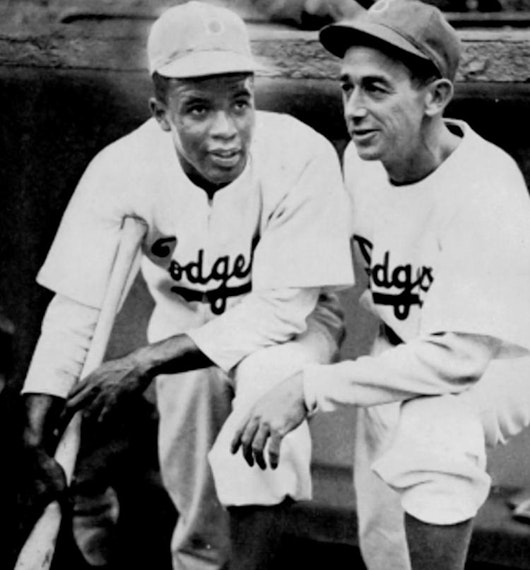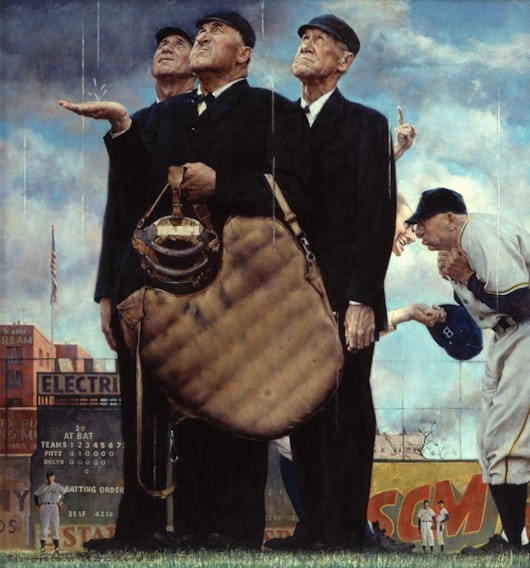Clyde Sukeforth: Baseball’s Forrest Gump?
By PJ Shelley, Tour and Programming Director
At some point during my 8+ years of working for Louisville Slugger Museum & Factory, I've become the museum's "Signature Wall Guy."
The Wall (pictured below) showcases the nearly 9,000 players who have signed contracts with H&B since 1905. Our frontline staff is great at helping our guests find names like Ruth, Musial, or Clemente. But when visitors are looking for, “that guy with the mustache that played for that blue team in the ‘80s,” or “that guy with the ears who hardly ever struck out,” I get summoned. After I question our guest about mustache specifics and such, as if I were Joe Friday from Dragnet, I’m pointing at Steve Balboni and Joe Sewell’s signature on our Wall.

I’ve channeled that skillset to create one of our newest programs: The Signature Wall Spotlight. We’re giving guests a tour of our Signature Wall while highlighting some fascinating stories that many staunch baseball fans may not know.
One of my favorites is the story of Clyde “Sukey” Sukeforth, who we signed to a bat contract in 1927 (signature pictured below). Sukeforth was a college educated guy who successfully parlayed his playing days into a coaching career, an accomplishment that requires smarts and skills. But much like the fictitious Forrest Gump, who witnessed many defining moments of the 20th Century by fate or luck, Sukeforth also found himself in the middle of many iconic baseball moments of the century.



A backup catcher with a 10-year career split between the Reds and the Dodgers, Sukeforth wrapped up his playing career with the Dodgers and managed several of their farm system teams in the late 1930s and early 1940s.
In 1945, during World War II, the 43-year-old coached for the Dodgers in Brooklyn and occasionally filled in at catcher because of the wartime manpower shortage. Later that season, Dodgers’ president Branch Rickey sent Sukeforth to Chicago to implore a Kansas City Monarchs player named Jackie Robinson to meet with Rickey in Brooklyn. Jackie and “Sukey” took a train to Brooklyn. And, Sukeforth was the only other person in the room during that fateful meeting between Branch Rickey and Jackie Robinson, when Rickey laid out his plans to sign Robinson to a contract and break the color barrier in the major leagues.
During spring training in 1947, just as Robinson was poised to make his historic debut on Opening Day, Dodgers manager Leo Durocher was suspended. Sukeforth was tapped as the interim manager, and it was he, not Durocher, who wrote Robinson’s name in the Opening Day lineup on April 15th.


The following year, Norman Rockwell visited Brooklyn’s Ebbets Field to photograph some Dodgers and umpires for a painting he was working on. Coach Sukeforth modeled for the photos. He can be seen smiling and pointing to the sky in Rockwell’s iconic Tough Call featuring three umpires looking up at the sky to determine if the game should be called for rain. We displayed the painting at Louisville Slugger Museum & Factory in our 2011 exhibit, Norman Rockwell: Sports.
In 1951, Sukeforth was the bullpen coach in the decisive third game of the National League pennant playoff. When the Dodgers needed a reliever to face the Giants’ Bobby Thomson, Sukeforth had to choose between Carl Erskine or Ralph Branca. Erskine was bouncing his curves in the dirt short of the plate, so Sukeforth sent in Branca. Two pitches later, a crack of the bat became known as “the shot heard around the world,” and WMCA radio announcer, Russ Hodges, began screaming his unforgettable call of Thomson’s home run, “The Giants win the pennant! The Giants win the pennant! The Giants win the pennant! The Giants win the pennant!”
Sukeforth resigned from the Dodgers after that defeat, but quickly found a coaching position with the Pirates. In 1954, as a pitching coach and scout for the Pirates, he found himself in Richmond, Virginia scouting some Dodger prospects. He was impressed with one outfielder’s pre-game drills, who was largely being ignored by his former employers from Flatbush. Sukeforth convinced the Pirates to grab the outfielder when he was left unprotected in the Rule 5 draft.
That 19-year-old outfielder was a Puerto Rican named Roberto Clemente.
Clyde Sukeforth passed away in 2000 at the age of 98. Not only did his life span countless iconic baseball moments of the 20th Century, but he was also part of them.
If you liked Sukeforth’s story, be sure to check out our Signature Wall Spotlight to learn about other unknown baseball greats. Check our Daily Programming all summer long for presentation times and more.
This is “Signature Wall Guy,” signing off . . . for now!
